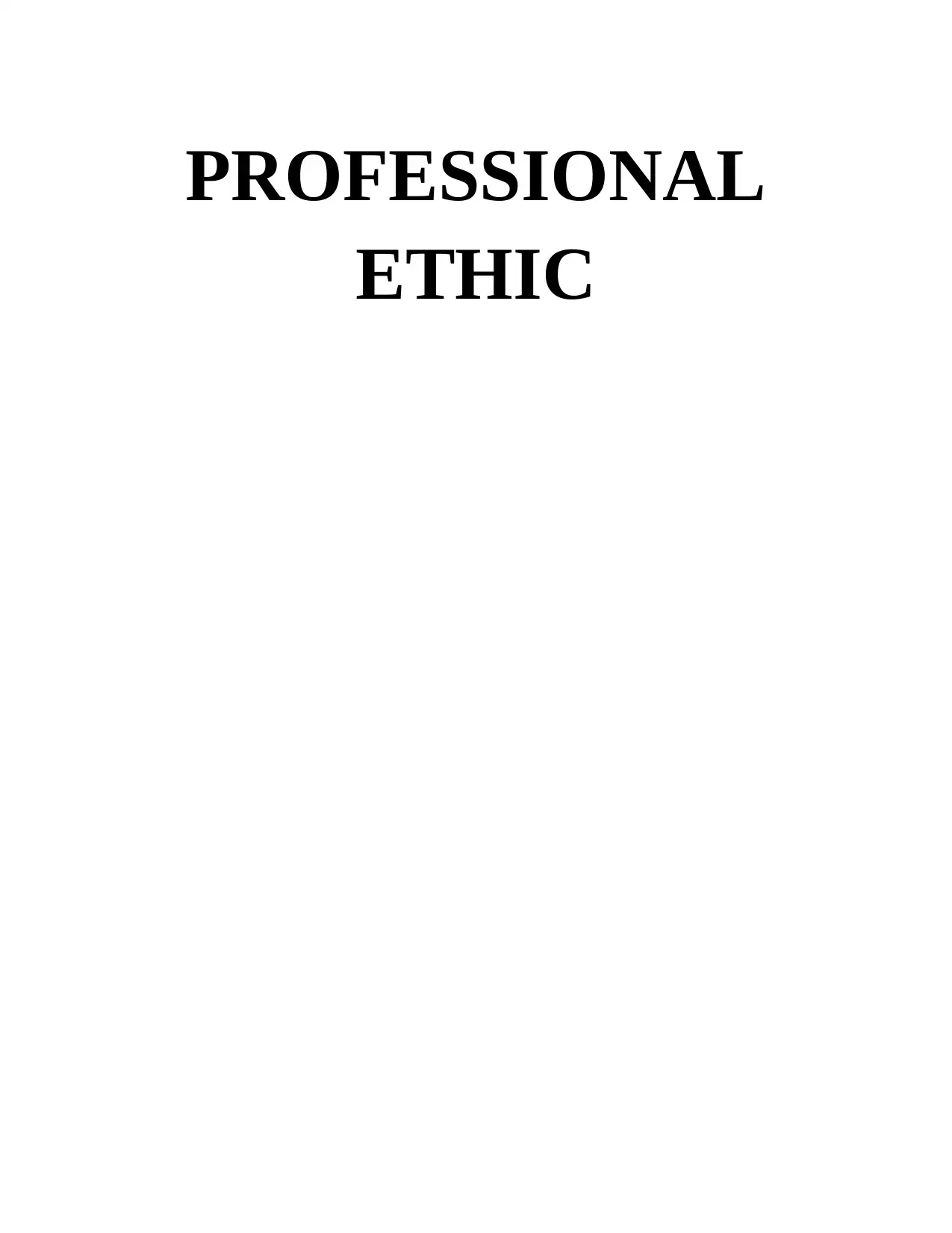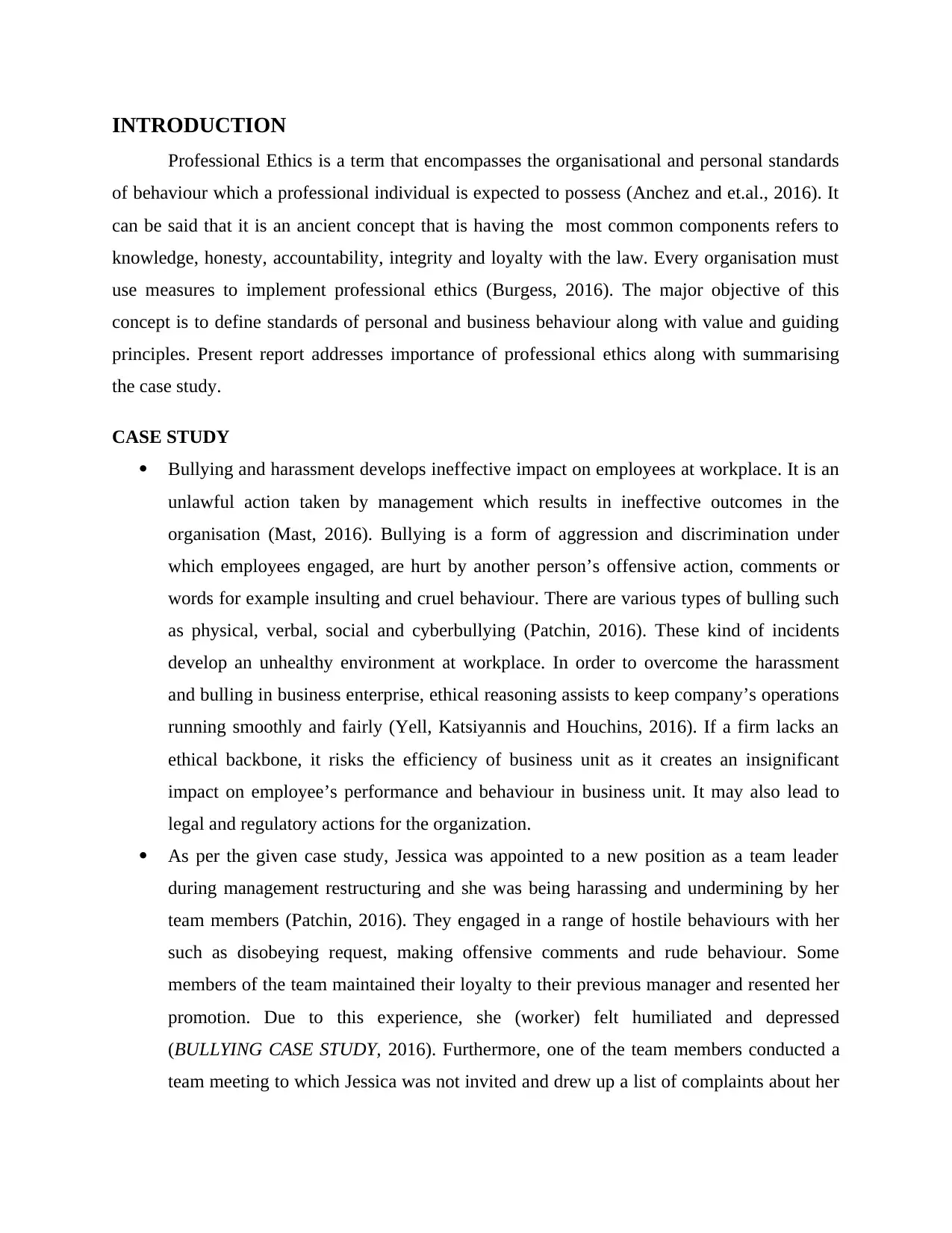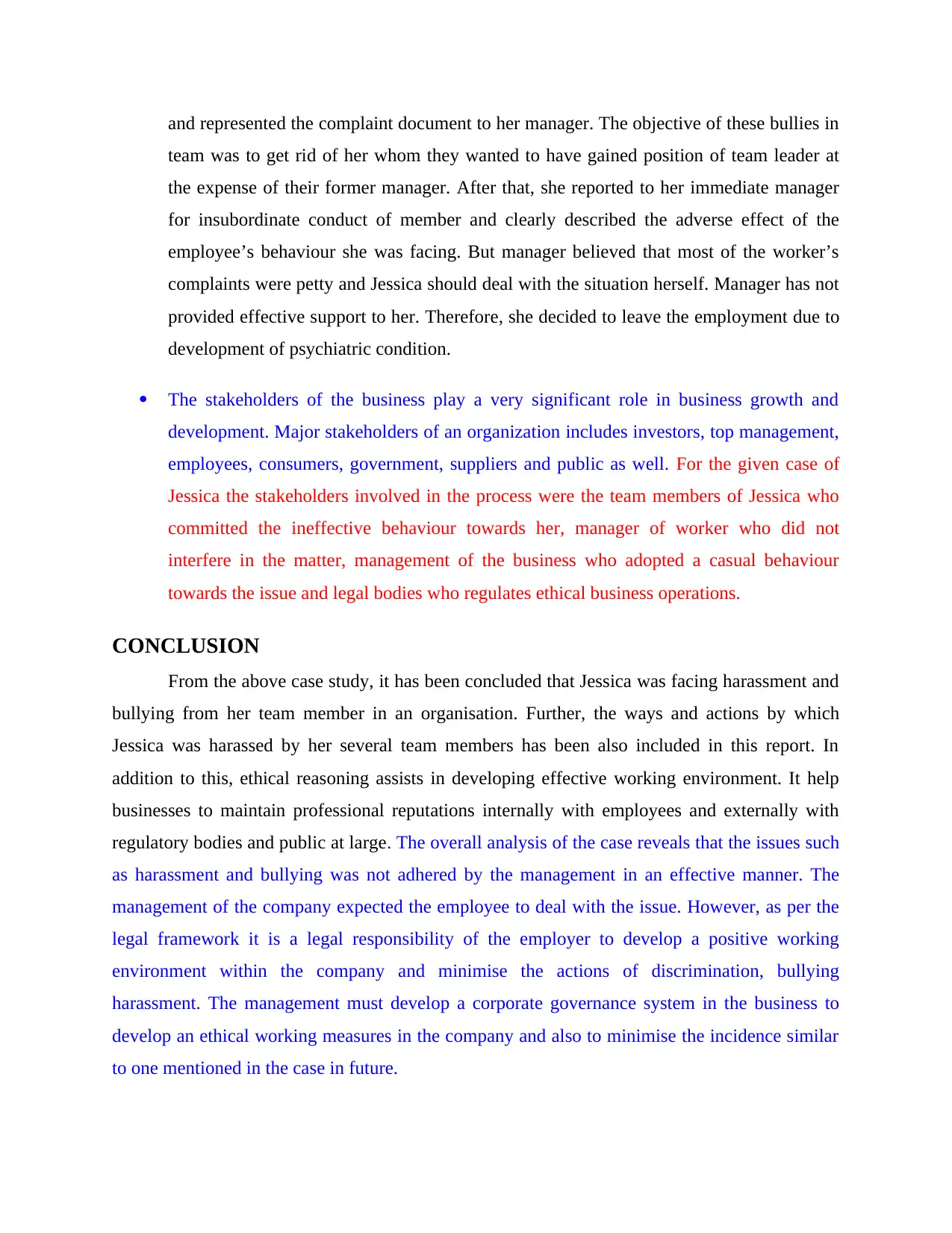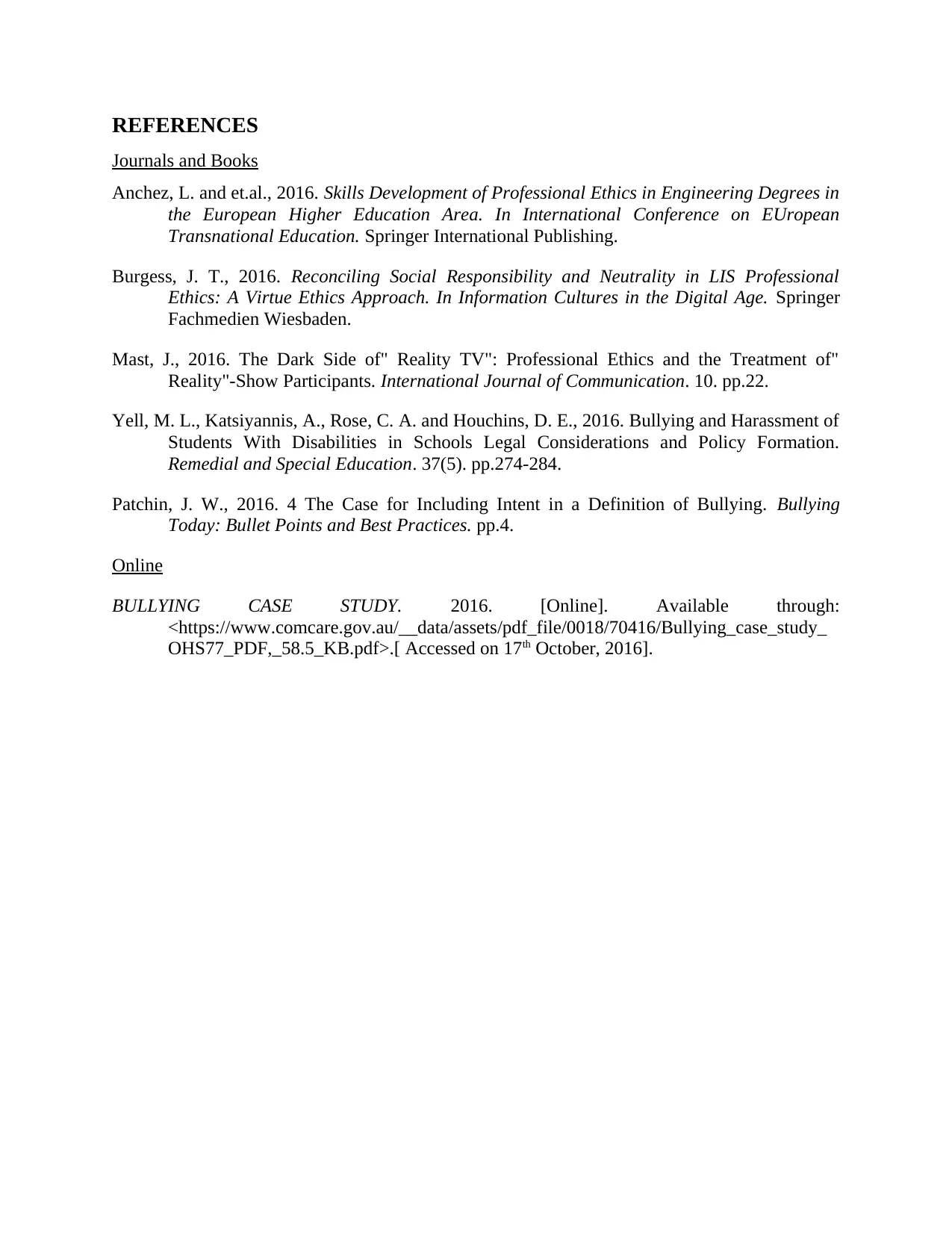Case Study: Professional Ethics and Workplace Bullying Analysis
VerifiedAdded on 2020/01/15
|5
|1048
|554
Case Study
AI Summary
This case study analyzes a scenario of workplace bullying and harassment, focusing on the ethical responsibilities of management and the impact on employees. The case involves a team leader, Jessica, who faces hostility and undermining behavior from her team members after a management restructuring. The analysis highlights the importance of ethical reasoning in maintaining a positive work environment and the consequences of a lack of support from management. The stakeholders involved include the team members, Jessica's manager, the broader management, and regulatory bodies. The study concludes that the management failed to address the harassment effectively, emphasizing the legal responsibility of employers to prevent discrimination and foster a safe workplace. The report underscores the need for corporate governance systems to promote ethical conduct and prevent similar incidents in the future. The provided solution is available on Desklib, offering students access to past papers and solved assignments for study and review.

PROFESSIONAL
ETHIC
ETHIC
Paraphrase This Document
Need a fresh take? Get an instant paraphrase of this document with our AI Paraphraser

INTRODUCTION
Professional Ethics is a term that encompasses the organisational and personal standards
of behaviour which a professional individual is expected to possess (Anchez and et.al., 2016). It
can be said that it is an ancient concept that is having the most common components refers to
knowledge, honesty, accountability, integrity and loyalty with the law. Every organisation must
use measures to implement professional ethics (Burgess, 2016). The major objective of this
concept is to define standards of personal and business behaviour along with value and guiding
principles. Present report addresses importance of professional ethics along with summarising
the case study.
CASE STUDY
Bullying and harassment develops ineffective impact on employees at workplace. It is an
unlawful action taken by management which results in ineffective outcomes in the
organisation (Mast, 2016). Bullying is a form of aggression and discrimination under
which employees engaged, are hurt by another person’s offensive action, comments or
words for example insulting and cruel behaviour. There are various types of bulling such
as physical, verbal, social and cyberbullying (Patchin, 2016). These kind of incidents
develop an unhealthy environment at workplace. In order to overcome the harassment
and bulling in business enterprise, ethical reasoning assists to keep company’s operations
running smoothly and fairly (Yell, Katsiyannis and Houchins, 2016). If a firm lacks an
ethical backbone, it risks the efficiency of business unit as it creates an insignificant
impact on employee’s performance and behaviour in business unit. It may also lead to
legal and regulatory actions for the organization.
As per the given case study, Jessica was appointed to a new position as a team leader
during management restructuring and she was being harassing and undermining by her
team members (Patchin, 2016). They engaged in a range of hostile behaviours with her
such as disobeying request, making offensive comments and rude behaviour. Some
members of the team maintained their loyalty to their previous manager and resented her
promotion. Due to this experience, she (worker) felt humiliated and depressed
(BULLYING CASE STUDY, 2016). Furthermore, one of the team members conducted a
team meeting to which Jessica was not invited and drew up a list of complaints about her
Professional Ethics is a term that encompasses the organisational and personal standards
of behaviour which a professional individual is expected to possess (Anchez and et.al., 2016). It
can be said that it is an ancient concept that is having the most common components refers to
knowledge, honesty, accountability, integrity and loyalty with the law. Every organisation must
use measures to implement professional ethics (Burgess, 2016). The major objective of this
concept is to define standards of personal and business behaviour along with value and guiding
principles. Present report addresses importance of professional ethics along with summarising
the case study.
CASE STUDY
Bullying and harassment develops ineffective impact on employees at workplace. It is an
unlawful action taken by management which results in ineffective outcomes in the
organisation (Mast, 2016). Bullying is a form of aggression and discrimination under
which employees engaged, are hurt by another person’s offensive action, comments or
words for example insulting and cruel behaviour. There are various types of bulling such
as physical, verbal, social and cyberbullying (Patchin, 2016). These kind of incidents
develop an unhealthy environment at workplace. In order to overcome the harassment
and bulling in business enterprise, ethical reasoning assists to keep company’s operations
running smoothly and fairly (Yell, Katsiyannis and Houchins, 2016). If a firm lacks an
ethical backbone, it risks the efficiency of business unit as it creates an insignificant
impact on employee’s performance and behaviour in business unit. It may also lead to
legal and regulatory actions for the organization.
As per the given case study, Jessica was appointed to a new position as a team leader
during management restructuring and she was being harassing and undermining by her
team members (Patchin, 2016). They engaged in a range of hostile behaviours with her
such as disobeying request, making offensive comments and rude behaviour. Some
members of the team maintained their loyalty to their previous manager and resented her
promotion. Due to this experience, she (worker) felt humiliated and depressed
(BULLYING CASE STUDY, 2016). Furthermore, one of the team members conducted a
team meeting to which Jessica was not invited and drew up a list of complaints about her

and represented the complaint document to her manager. The objective of these bullies in
team was to get rid of her whom they wanted to have gained position of team leader at
the expense of their former manager. After that, she reported to her immediate manager
for insubordinate conduct of member and clearly described the adverse effect of the
employee’s behaviour she was facing. But manager believed that most of the worker’s
complaints were petty and Jessica should deal with the situation herself. Manager has not
provided effective support to her. Therefore, she decided to leave the employment due to
development of psychiatric condition.
The stakeholders of the business play a very significant role in business growth and
development. Major stakeholders of an organization includes investors, top management,
employees, consumers, government, suppliers and public as well. For the given case of
Jessica the stakeholders involved in the process were the team members of Jessica who
committed the ineffective behaviour towards her, manager of worker who did not
interfere in the matter, management of the business who adopted a casual behaviour
towards the issue and legal bodies who regulates ethical business operations.
CONCLUSION
From the above case study, it has been concluded that Jessica was facing harassment and
bullying from her team member in an organisation. Further, the ways and actions by which
Jessica was harassed by her several team members has been also included in this report. In
addition to this, ethical reasoning assists in developing effective working environment. It help
businesses to maintain professional reputations internally with employees and externally with
regulatory bodies and public at large. The overall analysis of the case reveals that the issues such
as harassment and bullying was not adhered by the management in an effective manner. The
management of the company expected the employee to deal with the issue. However, as per the
legal framework it is a legal responsibility of the employer to develop a positive working
environment within the company and minimise the actions of discrimination, bullying
harassment. The management must develop a corporate governance system in the business to
develop an ethical working measures in the company and also to minimise the incidence similar
to one mentioned in the case in future.
team was to get rid of her whom they wanted to have gained position of team leader at
the expense of their former manager. After that, she reported to her immediate manager
for insubordinate conduct of member and clearly described the adverse effect of the
employee’s behaviour she was facing. But manager believed that most of the worker’s
complaints were petty and Jessica should deal with the situation herself. Manager has not
provided effective support to her. Therefore, she decided to leave the employment due to
development of psychiatric condition.
The stakeholders of the business play a very significant role in business growth and
development. Major stakeholders of an organization includes investors, top management,
employees, consumers, government, suppliers and public as well. For the given case of
Jessica the stakeholders involved in the process were the team members of Jessica who
committed the ineffective behaviour towards her, manager of worker who did not
interfere in the matter, management of the business who adopted a casual behaviour
towards the issue and legal bodies who regulates ethical business operations.
CONCLUSION
From the above case study, it has been concluded that Jessica was facing harassment and
bullying from her team member in an organisation. Further, the ways and actions by which
Jessica was harassed by her several team members has been also included in this report. In
addition to this, ethical reasoning assists in developing effective working environment. It help
businesses to maintain professional reputations internally with employees and externally with
regulatory bodies and public at large. The overall analysis of the case reveals that the issues such
as harassment and bullying was not adhered by the management in an effective manner. The
management of the company expected the employee to deal with the issue. However, as per the
legal framework it is a legal responsibility of the employer to develop a positive working
environment within the company and minimise the actions of discrimination, bullying
harassment. The management must develop a corporate governance system in the business to
develop an ethical working measures in the company and also to minimise the incidence similar
to one mentioned in the case in future.
⊘ This is a preview!⊘
Do you want full access?
Subscribe today to unlock all pages.

Trusted by 1+ million students worldwide

Paraphrase This Document
Need a fresh take? Get an instant paraphrase of this document with our AI Paraphraser

REFERENCES
Journals and Books
Anchez, L. and et.al., 2016. Skills Development of Professional Ethics in Engineering Degrees in
the European Higher Education Area. In International Conference on EUropean
Transnational Education. Springer International Publishing.
Burgess, J. T., 2016. Reconciling Social Responsibility and Neutrality in LIS Professional
Ethics: A Virtue Ethics Approach. In Information Cultures in the Digital Age. Springer
Fachmedien Wiesbaden.
Mast, J., 2016. The Dark Side of" Reality TV": Professional Ethics and the Treatment of"
Reality"-Show Participants. International Journal of Communication. 10. pp.22.
Yell, M. L., Katsiyannis, A., Rose, C. A. and Houchins, D. E., 2016. Bullying and Harassment of
Students With Disabilities in Schools Legal Considerations and Policy Formation.
Remedial and Special Education. 37(5). pp.274-284.
Patchin, J. W., 2016. 4 The Case for Including Intent in a Definition of Bullying. Bullying
Today: Bullet Points and Best Practices. pp.4.
Online
BULLYING CASE STUDY. 2016. [Online]. Available through:
<https://www.comcare.gov.au/__data/assets/pdf_file/0018/70416/Bullying_case_study_
OHS77_PDF,_58.5_KB.pdf>.[ Accessed on 17th October, 2016].
Journals and Books
Anchez, L. and et.al., 2016. Skills Development of Professional Ethics in Engineering Degrees in
the European Higher Education Area. In International Conference on EUropean
Transnational Education. Springer International Publishing.
Burgess, J. T., 2016. Reconciling Social Responsibility and Neutrality in LIS Professional
Ethics: A Virtue Ethics Approach. In Information Cultures in the Digital Age. Springer
Fachmedien Wiesbaden.
Mast, J., 2016. The Dark Side of" Reality TV": Professional Ethics and the Treatment of"
Reality"-Show Participants. International Journal of Communication. 10. pp.22.
Yell, M. L., Katsiyannis, A., Rose, C. A. and Houchins, D. E., 2016. Bullying and Harassment of
Students With Disabilities in Schools Legal Considerations and Policy Formation.
Remedial and Special Education. 37(5). pp.274-284.
Patchin, J. W., 2016. 4 The Case for Including Intent in a Definition of Bullying. Bullying
Today: Bullet Points and Best Practices. pp.4.
Online
BULLYING CASE STUDY. 2016. [Online]. Available through:
<https://www.comcare.gov.au/__data/assets/pdf_file/0018/70416/Bullying_case_study_
OHS77_PDF,_58.5_KB.pdf>.[ Accessed on 17th October, 2016].
1 out of 5
Related Documents
Your All-in-One AI-Powered Toolkit for Academic Success.
+13062052269
info@desklib.com
Available 24*7 on WhatsApp / Email
![[object Object]](/_next/static/media/star-bottom.7253800d.svg)
Unlock your academic potential
Copyright © 2020–2025 A2Z Services. All Rights Reserved. Developed and managed by ZUCOL.




